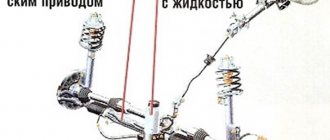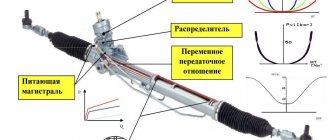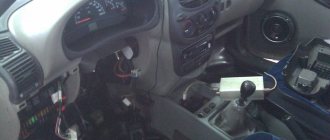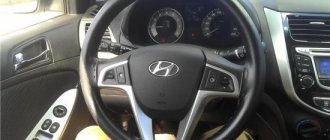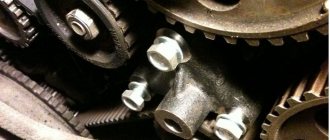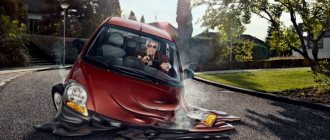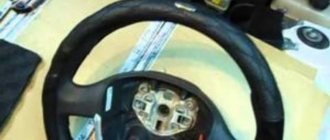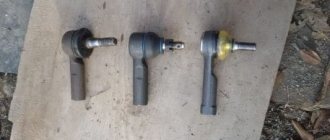A little theory: front suspension design
Before attempting to fix any problem, there is a tendency to look at the blueprints or repair manual. It is known that the VAZ-2192 parts catalog contains the following object:
This is what the steering rack looks like in the drawing
Whether the knock will remain in the steering rack of Kalina-2 depends on the following: how accurately element “14” is adjusted. The adjusting nut, marked “14”, looks almost invisible here. But first impressions are deceiving. In the catalog, by the way, the element is called “Stop Nut”.
It is important to know that the thrust nut has external threads. And it spins clockwise. And the words “tighten the rack” mean screwing in the specified nut, and nothing more.
Now let's move on to practice and see what the node in question looks like in reality:
If you remove the rail, it looks like this
The nut has a non-standard notch, and it can only be rotated with a special tool. By the way, the recess will be closed with a cap. In the catalog it is designated by the number “15”, and now, let’s look at the appearance of the special key:
Rack adjustment key
The thrust nut is turned at small angles. We are talking about values of 10-15 degrees. What happens if you overdo it with tightening the rack? The knocking noise will disappear, but the steering wheel will turn with difficulty. Therefore, if necessary, the nut can be pulled back.
content .. 13 14 15 16 ..Lada Kalina. Basic steering faults
Sign
| Probable Cause | Elimination method | |
| Increased free play of the steering wheel | The connection in the universal joint is loose | Tighten |
| Steering gear bolts are not tightened securely | Tighten the bolts | |
| Excessive play or wear in the tie rod end | Replace the tie rod end | |
| The steering wheel is difficult to turn | Insufficient belt tension | Adjust the belt tension |
| Belt damage | Replace the belt | |
| Add liquid | Low fluid level | |
| Air in liquid | Remove air from liquid | |
| Hoses are pinched or damaged | Position correctly or replace | |
| Insufficient pressure generated by the pump | Repair or replace pump | |
| Pressure control valve stuck | Replace |
| Sign | Probable Cause | Elimination method |
| The steering wheel is difficult to turn | Pressure control valve stuck | Replace |
| Internal leaks in the power steering pump | Replace damaged parts | |
| Excessive fluid leakage from the rack and pinion into the steering gear housing | Replace damaged parts | |
| Damage to steering gear housing or pressure control valve | Replace damaged parts | |
| The steering wheel does not return to its original position properly | The torque of the ball joint of the tie rod end is too high | Replace the tie rod end |
| Universal joint too tight | Adjust | |
| The inner tie rod joint or ball joint is difficult to turn | Lubricate or replace the ball joint | |
| The steering gear fastening in the bracket is loose | Tighten | |
| Worn steering shaft joints or body O-ring | Replace | |
| Damaged steering gear | Replace the steering gear | |
| Damaged steering gear bearing | Replace | |
| Hoses are kinked or damaged | Replace hoses | |
| Damaged pressure control valve | Replace | |
| Damaged power steering pump shaft bearing | Replace | |
| Extraneous noise during steering operation | Hissing sound in steering gear All power steering produces additional noise. One of the most common is a hissing sound when the steering wheel is turned while the vehicle is stationary. This sound will be most obvious when turning the steering wheel with the brake pedal depressed. There is no relationship between this noise and steering performance. Do not replace the valve unless the hissing noise becomes extreme. The new valve will also make some noise. | |
| Rumbling sound in steering gear | Play between hoses and car body | Properly route and secure the hoses |
| Steering gear is not secured | Secure the steering gear | |
| The tie rod end and/or ball joint are not secured | Tighten connections | |
| Worn tie rod end and/or ball joint | Replace | |
| Power steering pump noise | Low fluid level | Add liquid |
| Air in liquid | Remove air | |
| Pump mounting bolts are not tightened | Tighten the bolts | |
Power steering problems
| Possible causes of malfunction | Remedy |
| Increased free play of the steering wheel | |
| Loosening the rack stop adjusting screw | Tighten |
| Loosening the steering gear mounting bolts | Tighten |
| Loose or worn tie rod ball joints | Tighten fastenings or replace hinges |
| Stiff steering wheel rotation (insufficient reinforcement) | |
| Slipping of the power steering pump drive belt | Adjust belt tension |
| Damage to the pump drive belt | Replace belt |
| Insufficient working fluid level | Restore fluid level to normal |
| Air entering the hydraulic system - | Remove air |
| Kinked or damaged hoses | Remove kinks or replace hoses |
| Insufficient pressure of the hydraulic booster pump | Fix the problem or replace the pump |
| Distributor stuck | Replace |
| Increased internal leaks in the pump | Replace defective pump parts |
| Increased fluid leaks from the steering mechanism | Replace defective parts |
| Misaligned or damaged steering gear or distributor seals | Replace seals |
| Unclear return of the steering wheel to the center position | |
| Increased turning torque of ball joints of tie rod ends | Replace |
| Excessive tightening of the rack stop adjusting screw | Correctly tighten the screw |
| Difficulty turning internal joints and/or tie rod ends | Replace |
| Loosening the bolts securing the steering gear to the subframe | Tighten the bolts |
| Worn steering shaft universal joint and/or seal | Fix or replace |
| Deformation of the steering rack | Replace |
| Drive gear bearing damage | Replace |
| Kinked or damaged hoses | Remove kinks or replace hoses |
| Damage to the pressure control valve | Replace |
| Damage to the pump rotor shaft bearing | Replace bearing |
| Noise (knocking) in the steering | |
| Hoses touching the body | Route the hoses correctly |
| Loosening the steering gear bracket | Tighten the fastener |
| Loose tie rods and/or ball joints | Tighten the fastener |
| Worn steering rods and/or ball joints | Replace |
| Increased noise of the power steering pump | |
| Insufficient working fluid level | Restore fluid level to normal |
| Air entering the hydraulic system | Remove air |
| Loosening the pump mounting bolts | Tighten the bolts |
Troubleshooting steering without power steering
Increased free play of the steering wheel is possible for the following reasons: the presence of gaps in the hinges of the steering rods of the front wheels, a violation of the adjustment of the engagement of the worm and roller or their increased wear, wear of the bushings or the axis of the pendulum lever, loosening of the steering gear housing or the bracket of the pendulum lever. To determine the gaps in the steering rod joints, it is recommended that one person turn the steering wheel left and right with sharp movements, and the second person should touch or visually identify the gaps by pressing his fingers against the two parts connected by the hinges.
If one part of the connection moves and the other is stationary, then there is play; if both parts move simultaneously, then there is no play. You can also determine the play in the hinge joints by moving the rod with your hands in the longitudinal direction. If, for example, the longitudinal rod moves along with the bipod, then there is no play in the hinge joint. If even a small gap is detected in the hinge, it must be eliminated (replace the hinge).
Failure to adjust the engagement of the worm and roller or their increased wear is also determined when the steering wheel swings sharply (to the right and left from the middle position) by the appearance of knocking in the steering mechanism. You can do this directly by shaking the steering gear bipod with your hand. The malfunction is eliminated by adjusting the engagement of the worm and roller, and in case of significant wear, by replacing parts.
Wear of the bushings or the axis of the pendulum arm is determined by creaking and knocking noises when turning the wheels to the right and left, as well as when the pendulum arm directly swings up and down. The malfunction is eliminated by tightening the nut of the pendulum arm axis or replacing worn parts. Loose fastening of the steering gear housing and the pendulum arm bracket can be eliminated by tightening the corresponding bolts and nuts.
Stiff rotation of the steering wheel or jamming in the steering mechanism may be due to improper adjustment of the side clearance in the worm mesh, excessive tightening of the worm bearings, increased wear on the roller or worm, bent steering rods, insufficient oil in the steering gear housing, or thickening of the lubricant at low temperatures. air, low pressure in the tires of the front wheels.
If, when driving the car, you feel tight rotation of the steering wheel or jamming in the steering mechanism, then, first of all, you need to check the air pressure in the tires and the lubrication in the steering gear housing. Then check the condition of the steering rods. If the rods are bent, they must be straightened or replaced, and then the wheel toe must be adjusted. If the jamming does not disappear, you need to disassemble the steering mechanism and replace worn and damaged parts. Knocks in the steering have the same reasons as increased free play of the steering wheel. Their definition and methods of elimination were discussed above.
Lubricant leakage from the steering gear housing may occur due to wear of the bipod or worm shaft seal, loosening of the crankcase cover, or damage to the gaskets. The defect is eliminated by replacing worn oil seals or damaged gaskets, and tightening the cover bolts.
content .. 13 14 15 16 ..
Lyrical digression
In Lada Kalina, the steering rack never makes a knock when we are talking about a new car. This is also true for the break-in period. Let's say in your case this is not done. Then, do not try to repair anything, but go straight to the dealer. According to reviews, the defect in question is covered under warranty, and most car dealers do this: the steering rack assembly is replaced with a new one.
This is what the replacement unit looks like, the rack assembly
There is a logic here. At the factory, adjustments are made correctly (this is true in 99.9% of cases). If a defect appears, the dealer replaces the assembly without expecting that adjustment will solve the problem. The owner does not need to hope for this either. The choice is yours.
Making adjustments yourself
You can access the adjusting nut from the engine compartment, but to do this you will need to remove the battery, as well as the battery mounting pad. It is better to drive the car into a pit and then remove the crankcase protection (engine mudguard). If you look from under the bottom, the required element is immediately visible:
You need to turn this nut
And when you open the hood, you can feel the nut, but not see it. Its location is marked in the figure:
To make adjustments, place the key here
Before adjustment, remove the rubber cap from the recess. Its appearance is shown in the photo:
Remove the cap and install the key
If it is not entirely clear what exactly needs to be done, it is better to contact the service. The key is installed in the recess and then rotated 10-15 degrees.
When looking at the rack from above, turning the key clockwise corresponds to unscrewing it. The handle of the key comes from the center of the car - which means tightening is being done. By the way, the latter is true provided that the handle faces forward.
Preparatory actions, dismantling unnecessary parts
To remove the crankcase protection, you need to unscrew 4 screws located in one row near the bumper. Also, unscrew two screws having a standard size of M6x16. In some configurations, the protection consists of two parts, but in this case they are attached only with self-tapping screws. These words are illustrated by the following photo:
First, unscrew the “10” screws, and then the two “18” screws. In the second case, there will be more screws (eight).
Now let's look at how to remove the battery. First of all, disconnect its terminals. Then, you need to move the additional fuse box to the side. In general, actions are performed according to the photo:
It turns out that the steering rack can be repaired (video example)
The serviceability of the steering system of any car is an important safety requirement on the road. Repair of the steering rack on Kalina must be carried out when any suspicious sounds occur. As practice shows, many car enthusiasts are calm about the fact that when turning the steering wheel there is a knocking or creaking noise, but this may indicate that the steering rack is knocking. Repairing the steering rack on Kalina is best done at a service station, but you can do it yourself.
Steering mechanism: 1 – boot; 2, 20 – bolts; 3 – washer; 4 – oil seal; 5 – crankcase cover; 6, 17 – sealing rings; 7 – separator; 8 – drive gear with bearing; 9 – steering rack; 10 – left protective cap; 11 – rod support; 12 – bracket; 13 – plug; 14 – stop nut; 15 – stop spring; 16 – retaining ring; 18 – rack stop; 19 – stop liner; 21 – locking plate; 22 – cover plate; 23 – clamp; 24 – protective cover; 25 – right protective cap; 26 – steering gear housing
Causes of EUR failure
Why does the electric power steering on the Lada Kalina not work, turns off and refuses to work, what are the signs of a steering wheel with power steering knocking, jamming, biting or squeaking? To repair the system yourself, you need to know how diagnostics are carried out and what causes precede the breakdown. Most often, the failure of the amplifier is caused by a breakdown of the unit itself and the amplifier fails. Problems of this type are resolved by thoroughly checking the system to identify the exact problem.
As practice shows, often the inoperability of the electric amplifier (failure) is associated with a breakdown of the speed controller.
- the steering wheel is jammed,
- jams
- becomes tight
- and others
Because the speed controller sensor ensures activation and deactivation of the electric power steering under different driving modes. The amplifier on Kalina works if the car is moving at low speed. When the speed begins to increase, the booster automatically turns off, allowing for safer machine control when driving at high speeds.
So, briefly about the reasons for the inoperability of the EUR:
- The speed controller has failed or the control unit does not receive or disappears a signal from it. In this case, the reason may lie in either a breakdown of the sensor, damaged wiring, or poor contact of the controller with the on-board network.
- The voltage in the vehicle's electrical network has decreased. The reasons can be different, ranging from a dead battery and an inoperative generator to the use of inappropriate electrical equipment in the car.
- The permissible crankshaft speed has been exceeded.
- Incorrect operation or failure of the control module. Depending on the cause, the control unit may need to be repaired; more detailed diagnostics need to be done.
Design Features
The steering system of the Lada Kalina includes an electric power steering and a steering column that is adjustable in height and tilt. The steering mechanism is a steering rack with a variable transmission ratio. The rack engages with the engine crankcase through a gear having helical teeth, the pitch of which varies along the length of the rack. The figure shows the design of the Kalina steering rack.
The steering rack on Kalina is pressed against the gear by a spring. Friction is reduced by a plastic insert. The spring pressure is changed with an adjusting nut (the factory-set gap between the rack and the shaft is 0.1 mm). The second end of the rail rests against a plastic sleeve. Adjusting the gap helps eliminate knocking noises.
The steering system shaft is installed in bearings (one in the column bracket, the other in the electric booster housing). The column bracket is attached to the pedal bracket (front) and to the body bracket. The column bracket with the pipe is connected in the form of a hinge of two plates, which allows you to change the position of the steering wheel, and the range of movement is limited by the slots in the plates.
To fix the position of the pipe, there is a lever connected to the adjusting sleeve. It is screwed into a coupling bolt located in the slots of the plates. When you turn the lever, the bushing rotates, loosening the fixation of the plate, which allows you to change the position of the steering wheel. Springs between the plates and the bracket pull the pipe up when the fastening is loosened.
The steering system of the Lada Kalina has two tie rods and swing arms. The rod consists of external and internal tips and an adjusting threaded sleeve, which, when rotated, changes the length of the rod. The required adjustment of the rods is fixed with bolts. The rod is connected to the swing arm using an external tip that has a ball-type joint.
Kalina's electric power steering reduces the force applied to the steering wheel. It is assembled on the basis of an electric motor with a gearbox located under the steering system casing. The amplifier is controlled by an electronic unit that receives signals from sensors of vehicle speed, shaft rotation and steering torque.
The principle of operation of the amplifier is based on the fact that when the car is stationary, the torque on the steering shaft is the greatest, and when moving, it decreases with increasing speed. There is a power steering indicator on the dashboard.
Purpose of the steering rack
In the photo, the steering rack is disassembled for diagnostics and replacement of lubricant
The steering rack or steering gear is designed to transmit force from the steering wheel to the wheels through special rods.
This device is one of the most basic parts of the steering and comes in three types:
- Mechanical - is installed less and less nowadays.
- Electric - if overheated, the electric motor may fail.
- Hydraulic - in such devices a hydraulic pump is mounted, which makes it easier to turn the steering wheel.
Adjusting the spring and power steering
Very often, the cause of a knocking sound when turning the steering wheel is a weakening of the pressure spring. It provides the required force for pressing the steering rack gear against the main shaft gear, which is set at the factory by adjusting and fixing the spring. As the vehicle is used, the spring loses its elasticity and relaxes.
In order to increase the pressing force of the spring, it is necessary to tighten it, which is done after disconnecting the steering mechanism, but without removing the steering rack. Repairing the steering rack in this case consists of setting the required gap between the rack and the shaft gear. The steering rack is installed in the middle position and is secured against movement.
The rubber plug is removed, and the indicator probe is placed in the hole of the stop adjusting nut so that it comes into contact with the rack stop. It is better to use a dial indicator. Then, turning the gear shaft that pushes the stop, the indicator measures the size of the stop's movement. The length of movement should not exceed 0.05 mm.
If this value is exceeded, it is eliminated by turning the adjusting nut. The steering rack is fixed in the position corresponding to the required clearance, and the ease of rotation of the pinion shaft is checked within the entire possible movement of the rack.
The adjustment nut is rotated using a special wrench for adjusting VAZ steering racks. It is not recommended to tighten the nut too much, which can have a negative effect when turning the steering wheel at maximum speed. If there is play when turning the steering wheel, the spring can be tightened by practically selecting the correct force.
In this case, initially the adjusting nut is turned by 20-25°, and the presence of knocking is checked when the rack is turned. If the noise is not eliminated, then tighten the nut again by 10-15°, and so on until the knocking noise is eliminated. If tightening the spring does not help, the steering rack needs to be repaired.
Adjusting Kalina's electric power steering is best done after removing the steering rack, but it can be done without dismantling with some inconvenience. The car is placed on the repair pit so that from below there is access to the mounting of the front part of the amplifier.
The clamping nut is tightened by turning clockwise from below, and when tightening the nut from above, respectively, counterclockwise. For the purpose of prevention, you should check the condition of the oil seal, since when the steering wheel is turned too much, the oil seals quickly wear out. At the same time, all elements are lubricated, especially the steering rod boots.
EUR malfunctions and their diagnosis
Despite the simplicity of the design of the unit we are considering, if the need for repair arises, it is difficult to carry out; there are different malfunctions and the methods of elimination are often complex. An important “aggravating” circumstance is the poor location of the mechanism. The manufacturer placed this module directly under the radiator of the LADA Kalina interior heating circuit.
Operation in cold weather has a temperature effect on the electric power steering. Over time, this factor causes malfunctions in the amplifier. This phenomenon is very common for Lada Kalina. If a unit fails, the driver immediately feels it becomes more difficult to control the car at low speeds. The most common factors leading to electrical amplifier malfunctions can be grouped into the following areas:
- the speed sensor “does not respond” and does not send signals to the ECU;
- the on-board network “suffers” from low voltage;
- the maximum speed has exceeded the permissible limit;
- The control module has become unusable.
The identified malfunctions and solutions will be discussed below. When the ignition is turned on, the ECU independently diagnoses the amplifier system for possible failures and malfunctions. If there is no signal from any of the sensors, the on-board controller automatically identifies this sensor as faulty, and the corresponding lamp on the display on the front panel of the cabin immediately lights up. This indicator looks like a steering wheel with an exclamation mark and is highlighted in orange.
The instructions supplied by the factory to the LADA Kalina car require immediate repairs if a malfunction is detected in the electric power steering mechanism, especially when the power is turned off. In such a situation, the driver should drive to the service center at low speed. Practice shows that this development of events does not always take place. An orange symbol on the dashboard may not indicate the need for repair procedures. It indicates the presence of a problem in one of the structural components of the system. Sometimes failures can occur in the supply circuit or one of the sensors has failed. These situations do not in any way affect the functionality of the node, and control control remains active.
If the steering wheel, after the indicated symbol is illuminated, has lost sensitivity, then a malfunction of this kind is considered quite dangerous, since it interferes with the normal functioning of the mechanism as a whole; it is also bad when the amplifier is turned off. Such problems arise quite often and really require urgent intervention. Ignoring this state of affairs may be associated with dire consequences for the LADA Kalina car. In order to quickly respond to a problem that has arisen, we quickly remove the fuse located in the panel block on the left side of the steering wheel. This measure prevents further damage to the electrical amplification system, since it completely deactivates it. You can go to the repair site, but you will need to apply more force to the steering wheel, because the amplifier is no longer functioning.
Grant sport engine
Error p0504 Lada Granta
Lada Granta low beam lamp
